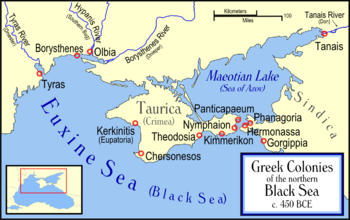- Olbia, Ukraine
-
Pontic Olbia (Ancient Greek: Ὀλβία Ποντική) or Olvia is the site of a colony founded by the Milesians on the shores of the Southern Bug estuary (Ὕπανις, Hypanis), opposite Berezan Island. Its harbour was one of the main emporia on the Black Sea for the export of cereals, fish, and slaves to Greece, and for the import of Attic goods to Scythia.[1]
Contents
Layout
The triangular site of the Greek colony covers the area of fifty hectares. The lower town (now largerly submerged by the Bug) was occupied chiefly by the dockyards and the houses of artisans. The upper town was a main residential quarter, composed of square blocks and centered on the agora with temples scattered in the vicinity. The town was ringed by a stone wall with towers.[2]
History
The Greek colony, highly important commercially, endured for a millennium. During the 5th century BCE, when the colony was visited by Herodotus, it minted distinctive cast bronze money in the shape of leaping dolphins.[3] Unusual in shape considering the round coins common in the Greek world, this form of money is said to have originated from sacrificial tokens used in the Temple of Apollo.
Martin Litchfield West speculates that early Greek religion, especially the Orphic Mysteries, was heavily influenced by Central Asian shamanistic practices. A large number of Orphic graffiti unearthed in Olbia seems to testify that the colony was one major point of contact.[4]
After the town adopted a democratic constitution, its relations with Miletus were regulated by a treaty, which allowed both states to coordinate their operations against Alexander's general Zopyrion in the 4th century BC. By the end of the 3rd century, the town declined economically[5] and accepted the overlordship of King Skilurus of Scythia. It flourished under Mithridates Eupator but was sacked by the Getae under Burebista, a catastrophe which brought Olbia's economic prominence to an abrupt end.
Having lost two thirds of its settled area, Olbia was restored by the Romans, albeit on a small scale and with a large admixture of barbarian population. Dio of Prusa visited the town and described it in his Borysthenic Discourse (the town was often called Borysthenes, after the river). The settlement, incorporated into the province of Lower Moesia, was eventually abandoned in the 4th century AD, when it was burnt at least twice in the course of the so-called Gothic (or Scythian) wars.
Excavation
The site of Olbia, designated an archaeological reservation, is situated near the village of Parutino in the district of Ochakov. Before 1902, the site was owned by the Counts Musin-Pushkins, who did not allow any excavations on their estate. Professional excavations were conducted under Boris Farmakovsky from 1901 to 1915 and from 1924 to 1926. As the site was never reoccupied, archaeological finds (particularly inscriptions and sculpture) proved rich. Today archaeologists are under pressure to explore the site, which is being eroded by the Black Sea.
Notes
- ^ Encyclopedia Of Ancient Greece (ed. by Nigel Guy Wilson). Routledge (UK), 2005. ISBN 0-415-97334-1. Page 510.
- ^ Wasowicz, Aleksandra. Olbia Pontique et son territoire : l'aménagement de l'espace Paris: Belles-lettres, 1975. OCLC 3035787 .
- ^ Odessa Numismatics Museum : Olbian Coins
- ^ M.L. West, The Orphic Poems, 1983, p.146.
- ^ A board of food commissioners was set up to distribute cereals among the population.
Further reading
- Krapivina, Valentina; Diatroptov, Pavel. "An Inscription of Mithradates VI Eupator's Governor from Olbia", Ancient Civilizations from Scythia to Siberia, Vol. 11, Issue 3/4. (2005), pp. 167–180.
- David Braund and S.D. Kryzhitskiy (eds), Classical Olbia and the Scythian World: From the Sixth Century BC to the Second Century AD (Oxford: Oxford University Press/British Academy, 2007) (Proceedings of the British Academy, 142).
- Alexander V. Karjaka, "The Defense Wall in the Northern Part of the Lower City of Olbia Pontike," in Pia Guldager Bilde, Jane Hjarl Petersen (ed.), Meetings of Cultures in the Black Sea Region: Between Conflict and Coexistence (Aarhus, Aarhus Universitetsforlag, 2008) (Black Sea Studies, 8), 163-180.
- Alexander V. Karjaka, "The Demarcation System of the Agricultural Environment of Olbia Pontike," in Pia Guldager Bilde, Jane Hjarl Petersen (ed.), Meetings of Cultures in the Black Sea Region: Between Conflict and Coexistence (Aarhus, Aarhus Universitetsforlag, 2008) (Black Sea Studies, 8), 181-192.
External links
- Ancient Coinage of Sarmatia, Olbia
- Blog about Olvia (Olbia) and artifacts found at its site
- Pyotr Osipovich Karyshkovskij-Ikar Coins of Olbia: Essay of Monetary Circulation of the North-western Black Sea Region in Antique Epoch. Киев, 1988. ISBN 5-12-000104-1.
- Pyotr O. Karyshkovskij-Ikar(fridmanbooks.netfirms.com)
North Pontic Greek colonies Tyras · Olbia · Borysthenes · Eupatoria · Chersonesos · Charax · Theodosia · Kimmerikon · Nymphaion · Tyritake · Panticapaeum · Myrmekion · Kepoi · Phanagoria · Hermonassa · Gorgippia · Pityus · Dioscurias · Tanais
 Categories:
Categories:- Ancient Greek cities
- Pontic Greeks
- Archaeological sites in Ukraine
- Milesian Pontic colonies
- Former populated places in Ukraine
Wikimedia Foundation. 2010.


